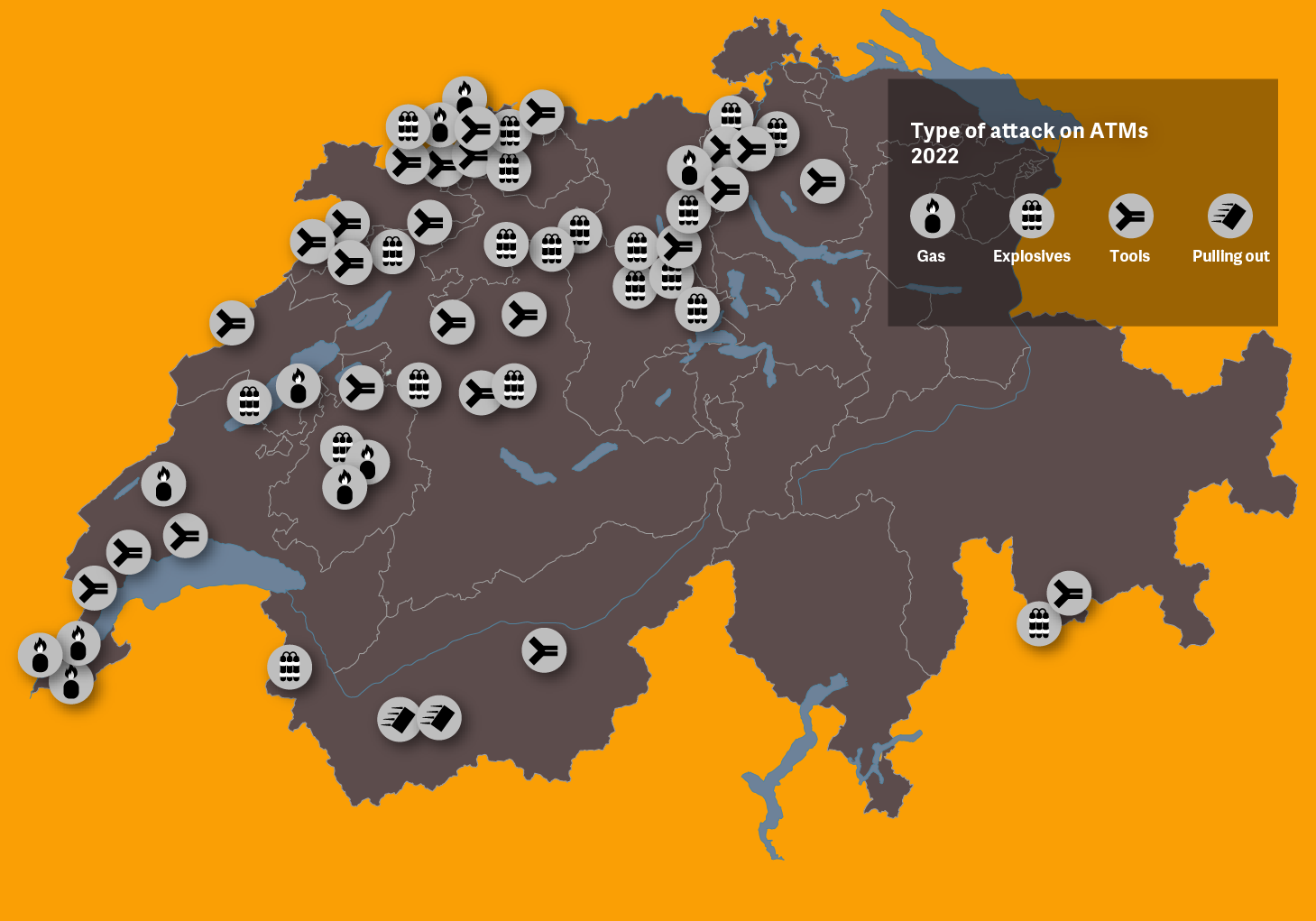
ATM attackers in the spotlight
Open the cash box – check. Insert the explosives or gas – check. Press ignition and take cover – check. ATM attackers act in a coordinated and efficient manner. Their modus operandi? It varies.
2022: 57 ATM attacks in 13 cantons. 20 explosions, 8 gas attacks and 25 ATMs broken open. More than ever before. And it is not just the border cantons that are affected anymore.
Who is behind it all? Findings so far suggest three to four types of perpetrator group: each specialises in a certain form of attack. The aim? The same in each case: grab as much cash as possible as quickly as possible and get out of Switzerland again as fast as possible.
Yet they all leave their tracks – so much is inevitable. And these provide evidence of the criminals’ modus operandi. They allow a picture to be developed:
Explosives? The perpetrators are mainly from Romania, Moldova or the Netherlands.
Gas? The evidence points to French, Serbian and Romanian gangs.
Brute force? These attacks tend to be the work of perpetrators from Albania or Kosovo.
Ready? Action!
For several weeks, fedpol, various cantonal police forces, detectives from Baden-Württemberg and the Central Office for Combating Itinerant Crime had been observing a Kosovar-Albanian group. There was evidence that they had carried out several ATM attacks in Switzerland and Germany. There was not long to wait – in a coordinated operation in the early hours of 25 July, three persons were arrested in France. Evidence obtained from the operation indicated that the suspects had been operating in various cantons and countries, using the Upper Alsace as their base. A crucial blow against this Kosovar-Albanian gang.
It is not simply the origins and methods of the perpetrator groups that differ; they also have preferences for different ATM locations and operate in different parts of Switzerland. They arrive under cover of darkness and strike between midnight and dawn.
The perpetrators are unscrupulous in their approach. They use explosives without a thought for what is in the vicinity, plunder the ATMs within a few minutes, and then share out the spoils. The three or four involved in each attack are linked to organised criminal networks. Experience shows that opportunist copycat offenders are a rarity.
ATM attacks require teamwork: one obtains the explosives, the other rents a hideout near the border. A third lays on the getaway vehicles. Often these are stolen cars with false or indeed no number plates. Most perpetrators flee at breakneck speed in a car. Some, however, have been known to use a scooter.
They are hooded, so it is difficult to identify anyone. This makes forensic evidence all the more important in the investigations. Fingerprints or traces of DNA are checked against AFIS and CODIS, the fingerprint and DNA databases, and compared with known profiles. Time and again there are hits.
Hits provide names. In most cases, these are not unfamiliar – the perpetrators operate in other criminal fields. The gangs from Romania and Moldova turn their hand to any type of property offence, even simple shoplifting. Or they are active in the prostitution industry. The Dutch gangs have links to the Mocro Maffia, which is based mainly in the Netherlands and in Belgium. The Moroccan Mafia is one of the biggest players on the European drugs scene; they are suspected of being behind the murder of the Dutch journalist Peter de Vries.
The links to organised crime show that ATM attackers are not petty criminals. Quite the opposite: they are well-organised, quick and always one step ahead of the police.
In the campaign against ATM attackers, every approach is needed: cooperation, law enforcement and prevention. This is why fedpol has since 2021 run a national ATM task force. This unites police divisions for forensic analysis, investigations, operations, communications and prevention with agents from the cantonal criminal investigation departments, the Federal Office for Customs and Border Security and the Forensic Institute in Zurich. The aim: to achieve a rapid and coordinated impact within Switzerland’s federalist law enforcement system.
- > Boom!
- > Encrypted chats between members of criminal organisations
- > Harvest time
- > The key for accessing encrypted content
- > No end to a hard day’s work for a mafia investigator
- > Far more than propaganda
- > Reichsbürger? In Switzerland?
- > Counterterrorism
- > Armed against crimes for which there is no statute of limitations